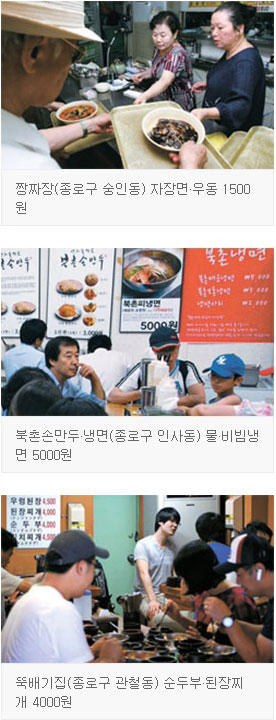Eateries attract with low prices

“I come here from Daechi-dong in southern Seoul for the jjajangmyeon,” Lee Cheol-su, 52, told the JoongAng Ilbo on Friday. “I’m always satisfied with the taste and the price, even though I have to pay for transportation to get here.”
Owner Jang In-jong, 51, said he has raised the price for his jjajangmyeon by only 500 won since he opened the restaurant in 1990. His secret is that he keeps labor costs to a minimum. He goes to a market every morning to buy the ingredients himself and employs no wait staff. Customers are asked to pick up their orders and return the plates to the kitchen when they are done. Delivery service isn’t available.
“Food prices have increased, but only by 10 percent,” Jang said. “Some customers suspect our ingredients are of poor quality, but we only use food from Korea, except napa cabbage.”
Despite inflation and rising food prices, some restaurants have refused to raise their prices in order to accommodate customers looking for reasonably priced meals.
Yun Jeong-hui, 36, owner of the naengmyeon (cold noodles) restaurant Bukchon Dumpling in Insa-dong, central Seoul, lowered the price of her noodles from 7,000 won to 5,000 won, which is about 4,000 won less than other restaurants in the area.
“I’ve changed the way I operate to save energy and labor costs, which keeps prices low,” Yun said.
Most owners of so-called samaritan restaurants like these said in interviews with the JoongAng Ilbo that claims about a surge in food prices are “exaggerated.”
“Other restaurants are only raising their prices because everybody else is doing it,” O Jong-hwan, 45, who owns a chicken restaurant called Happy Table in Sinchon, said. O has frozen the prices of all of his dishes at 4,900 won. “But I doubt whether they’ve improved the quality of the food.”
Kim Seung-gi, CEO of Korea Food Business Institute, said, “Most samaritan restaurants have improved their distribution systems and use seasonal ingredients. Local governments need to be involved in stabilizing food prices, by promoting these restaurants or building efficient distribution channels for local restaurants.”
By Nam Hyung-suk, Hyeon Hye-ran [heejin@joongang.co.kr]
Bukchon Dumpling in Insa-dong, downtown Seoul, has become a popular eatery for its low prices and tasty dishes made with domestic ingredients. By Jo Je-gyeong
한글 관련 기사 [중앙일보]
자장면 1500원, 냉면 5000원 … ‘착한 점심값’ 비밀
‘점심값 1만원 시대’ … 거꾸로 간 음식점 주인들에게 물어보니
‘한 그릇에 1500원.’ 서울 숭인동에 있는 중국음식점 ‘짱짜장’의 자장면 값이다. ‘점심값 1만원 시대’가 된 요즘 분위기와 사뭇 어울리지 않는 가격이다. 점심과 저녁 식사시간마다 15개 남짓한 테이블에 사람들이 꽉 차고 문 밖에는 손님들이 줄을 선다.
지난 5일 이 가게를 찾은 이철수(52)씨는 “대치동에서 자장면 먹으러 여기까지 왔다”며 “맛도 뒤지지 않고 교통비 등을 생각해도 만족도가 높다”고 말했다. 사장 장인종(51)씨는 “1990년 개업 이후 20년 동안 자장면 값을 500원밖에 올리지 않았다”고 했다.
장씨가 말하는 음식값 유지의 비결은 직접 뛰며 인건비를 줄이는 것. 장씨는 매일 새벽 청량리시장에 나가 식재료를 직접 산다. 배달은 하지 않고, 음식 나르기와 그릇 반납 등은 ‘셀프 서비스’다. 장씨는 “재료 값이 많이 오르긴 했지만 하늘 무서운 줄 모르고 치솟는 정도는 아니다”고 말했다. 그는 “싸구려 재료를 쓰는 것 아니냐고 의심하는 손님도 더러 있지만 우리 가게는 배추를 제외한 주재료가 모두 국내산”이라며 “한 그릇 만드는 데 식재료 값은 기껏해야 500원 내외다. 여기에 인건비와 임대료를 고려해도 한 그릇을 팔면 600원 이상 남는다”고 말했다.
인사동에 있는 ‘북촌 손만두·냉면’은 냉면 한 그릇을 5000원에 판다. 사장 윤정희(36)씨는 지난해 이 식당을 차리기 전 수유리에서 냉면집을 운영했다. 당시 냉면 한 그릇 가격은 7000원. 임대료가 더 비싼 서울 중심부로 가게를 옮겼는데 가격은 오히려 2000원 떨어진 것이다. 윤씨는 “냉면 생산 방식을 바꿔 기계 유지비를 아끼고 인건비를 줄이니 가격을 낮출 여유가 생겼다”고 말했다. 하루에 찾는 손님은 평균 500명 이상. 최근에는 홍익대 인근에 분점을 낼 만큼 번창했다.
이처럼 ‘착한 가격 음식점’들은 하나같이 “식재료 값이 올라 가격 상승이 불가피하다는 주장은 과장된 측면이 있다”고 지적한다. 구의동에서 43년째 영업을 하고 있는 평양냉면집 ‘서북면옥’ 역시 5년째 ‘한 그릇 6000원’을 유지하고 있다. 서울 시내 유명 평양냉면집 냉면 값이 ‘9000~1만1000원’인 것에 비하면 지극히 낮은 가격이다. 이경미(53) 사장은 “손님들이 오히려 ‘왜 안 올리느냐’고 묻는다”며 “오래된 고객의 신뢰를 잃지 않아야 한다는 게 우리 원칙”이라고 밝혔다.
서울 신촌의 퓨전음식점 ‘해피테이블’의 사장 오종환(45)씨는 “너도나도 (가격을) 올리니까 덩달아 올리는 경향이 있다”며 “상인들이 가격을 올린 만큼 그 음식에 다시 투자했는지는 의문”이라고 말했다. 오씨의 가게는 치킨 데리야끼 등 음식점 전 메뉴를 4900원으로 통일해 신촌에 거주하는 대학생들 사이에서 인기가 높다. 종로2가에 있는 ‘뚝배기집’의 김운식(49) 사장은 “배추 한 포기 값이 오르더라도 그 한 포기로 요리할 수 있는 음식의 양은 여전히 많다”며 “음식 1인분에 오른 배추 값을 반영하는 것은 손님에게 지나치게 떠넘기는 것”이라고 지적했다. 김씨는 “음식값이 싸다고 싼 재료를 쓸 것이라는 생각은 오해”라고 덧붙였다.
김승기 한국외식개발연구소장은 “‘착한 음식값’ 가게들은 대부분 유통구조를 개선하고 계절에 적합한 재료를 사용하는 등 사업적 수완을 발휘한 경우”라며 “장기적인 안목에서 이들의 전략이 더 큰 이득을 안겨줄 것”이라고 내다봤다. 김 소장은 “서울시 등 지자체에서 음식값 안정에 적극적으로 관여할 필요도 있다”며 “지역 음식점 유통라인을 지자체가 나서서 확보해 주는 방법도 있다”고 말했다.










with the Korea JoongAng Daily
To write comments, please log in to one of the accounts.
Standards Board Policy (0/250자)